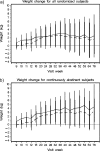A randomized, controlled trial of bupropion sustained-release for preventing tobacco relapse in recovering alcoholics
- PMID: 19483180
- PMCID: PMC2699931
- DOI: 10.1093/ntr/ntp077
A randomized, controlled trial of bupropion sustained-release for preventing tobacco relapse in recovering alcoholics
Abstract
Introduction: Studies examining the efficacy of tobacco dependence treatment among recovering alcoholic smokers have produced mixed findings. We set out to investigate this issue further by conducting a randomized, double-blind, placebo-controlled trial of bupropion sustained-release (SR) for smoking relapse prevention among abstinent alcoholic smokers.
Methods: Participants (N = 195) met DSM-IV criteria for a history of alcohol abuse or dependence and had at least 1 year of continuous abstinence from alcohol and drugs. Open-label treatment with nicotine patch therapy was provided to all subjects for 8 weeks. The initial nicotine patch dose was determined by the subject's baseline serum cotinine concentration with an aim to achieve 100% cotinine replacement. All subjects who were confirmed abstinent from smoking throughout the final week of nicotine patch therapy (Week 8) were randomly assigned to receive bupropion SR 300 mg/day or placebo through Week 52.
Results: A total of 110 participants were randomized to the double-blind treatment. No significant difference was observed between the bupropion and placebo groups for rates of continuous smoking abstinence, 41.1% (95% CI = 28.1%-55.0%) versus 40.7% (95% CI = 27.6%-55.0%), respectively, p = 1.0, or point prevalence abstinence, 39.3% (95% CI = 26.5%-53.3%) versus 40.7% (95% CI = 27.6%-55.0%), respectively, p = 1.0, at the end of the treatment (Week 52). Relapse to alcohol occurred in 4% of subjects (n = 4) during the study.
Discussion: Treatment with bupropion SR among abstinent alcoholic smokers did not delay relapse or result in improved long-term smoking abstinence.
Figures


References
-
- American Psychiatric Association. Diagnostic and statistical manual of mental disorders (DSM-IV) Washington, DC: American Psychiatric Association; 1994.
-
- Burling TA, Ziff DC. Tobacco smoking: A comparison between alcohol and drug abuse in patients. Addictive Behaviors. 1988;13:185–190. - PubMed
-
- Cleary P, Guy W. Factor analysis of the Hamilton depression scale. Drugs Under Experimental and Clinical Research. 1987;1:115–120.
-
- Dale LC, Hurt RD, Offord KP, Lawson GM, Croghan IT, Schroeder DR. High-dose nicotine patch therapy. Percentage of replacement and smoking cessation. Journal of the American Medical Association. 1995;274:1353–1358. - PubMed
-
- DiFranza JR, Guerrera MP. Hardcore Smokers (letter) Journal of the American Medical Association. 1989;261:2634–2635. - PubMed
Publication types
MeSH terms
Substances
Grants and funding
LinkOut - more resources
Full Text Sources
Medical
Research Materials
Miscellaneous

